Melanie Edmonds's Blog, page 32
April 19, 2013
Writers’ Asylum: Challenge #1
I want you to imagine a couple. For those who write romance or erotica, I want you to make it a pairing that you wouldn’t normally write: if you write about gay couples, imagine a straight couple; if you write lesbians, write about two men instead; if you write about adults, choose teenagers or more mature characters. Be creative. Try to picture a couple you haven’t written before.
Who are these people? How do they relate to each other? Imagine them in a room, looking at each other, just looking, not speaking. What draws them to each other? Do they know each other well? Have they just met? Are they somewhere in between, still discovering each other? What is the dynamic between them? Who initiates interactions: a glance, a conversation, contact, sex?
What ignites their passion? Have they kissed yet? Have they crossed the sexual (panty) line? As they’re standing there, looking at each other, are they intoxicated with drugs, each other, all of the above, or nothing? Are they a slow burn or sudden fireworks against a wall?
The title of this challenge is Raunchy. Now write their sex scene.
Writers’ Asylum: Prologue

Prepare to walk the corridors of today. I can’t promise they’ll all be this straight.
(Picture by Snap-shooter!)
You’re going to be pushed out of your comfort zone today. You’re going to write things you wouldn’t normally try. That’s good. That’s why we’re here.
Be free with it. Be brave and bold. Be inspired.
On the hour, every hour until the end of the event, I’m going to give you a series of prompts. I’m going to help you build a picture in your mind, then tell you the title of the challenge and push you over the edge into writing about that picture.
You can interpret the prompts in any way you wish, though I encourage you to follow the guidelines where you can, even if they make you uncomfortable. Even if they take you to a strange place. You may wish to subvert the challenge, but in doing so, you might also miss the point. Give it a try. Explore it, see what happens; surprise yourself.
The goal is to write a thousand words for each challenge. You only have an hour, so this is all about getting that picture in your head down on paper without stopping to reconsider, edit, or chicken out. Push yourself, spin it out, worm yourself into the details of that picture and tease them out. Give us everything you’ve got and then some.
I will not ask to see your writing, though if you wish to share it, I thoroughly encourage you. You can send it to me privately, post it on your own site, post it here in the comments on this blog; wherever you please! It is entirely your own choice.
Now, take a few minutes to prepare yourself. Stretch, breathe. Clear your mental palate and summon a fresh, clean sheet of paper to your mind.
Because soon, we will begin.
Random Writing Tip #3: Suck
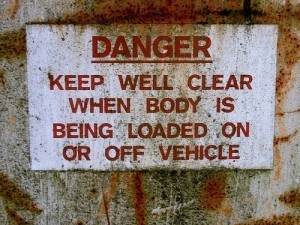
You could make as much sense as this sign. Or be this creepy and wrong. The choice is yours!
(Picture by Auntie P)
Writers have many stumbling blocks when it comes to putting words down on paper, including desire for quality and perfection, and fear of sucking. Here’s one tip to help you get past that.
You’re going to write crap. The sooner you accept this, the better.
Harsh? Maybe. But let’s be honest: everyone writes crap. Every writer needs to be edited before their words reach the outside world (and anyone who tells you different is lying or deluded).
But the thing to remember is: it’s okay to write crap. In fact, it’s better to write crap than to write nothing at all, because crap can be edited and made into something good. As I’ve seen attributed to several different writers: “I can edit a bad page, but I can’t edit a blank one.”
Letting the fear of sucking stop you from writing isn’t helpful or productive. Writers write, and if what you write sucks, you’re still a writer. Later, you can be an editor, and that’s when the gold starts to appear.
So let it happen. Let yourself suck. Can’t find the perfect place to start? Or that one ideal word that will break the seal on your virgin paper and spill forth brilliance? That’s because it’s busy folicking with the unicorns and fairies.
Pick any word. Pick a stupid one. Grab the first thing that pops into your head and put it down. Know you’re going to delete it? No problem, but follow it up with some other words first.
Experiment. If you’re not sure what that beautifully honed start looks like, try writing six different ones. Try writing everything that comes after that start, and then come back and decide which one works best. Some of them will be terrible. That’s fine. You’ve learned. You’ve moved on. And you’ll have the chance to whittle whatever’s left into the shape you really want it to be.
Don’t let perfection hold you back, because it doesn’t exist. Real life is dirty, flawed, and can always be improved upon, and writing is no different. Make a mess. Get drunk, do something ridiculous, do something inadvisable, vomit all over the floor, and then squint at it through the haze of your hangover*. Regret it? All of it? Are you sure?
Writers are special people who are perfectly capable of polishing a turd into a diamond. But first, you have to have the turd.
Go ahead. Suck hard. It’ll be worth it in the end when you’ve got words on the page that you can make into a story. When you show the world your diamond, none of them will guess that it started life as a stumbling, gross thing; all they’ll see is the diamond.
(*This is intended as a metaphor, but feel free to indulge in any way you please.)
April 15, 2013
Very: Bad
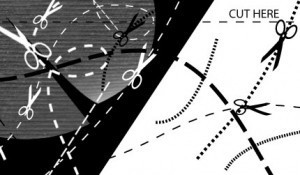
Go crazy with the cutting! Be ruthless!
(Picture by melemel)
There are some words that creep into our writing while we’re not looking. I’ve already talked about one of my bugbears; now it’s time to talk about another: quantifying adjectives or modifiers.
By this, I mean words like ‘very’, ‘some’, ‘a little’, ‘a lot’, ‘a bit’… you get the idea.
As a technical writer, I naturally lean towards precision. These kinds of quantifying modifiers offer more precision than bald nouns. “It’s a little cold out.” “He was very handsome.” “She shivered a bit.” All of these statements convey more of the image in my head than if they were missing those modifiers (“It’s cold out.” “He was handsome.” “She shivered.”)
But that doesn’t mean that those words belong in the sentence. It doesn’t mean that the sentence is the best that it can be.
As a rule of thumb, modifiers like these (and adjectives and adverbs) usually can (and should) be avoided by using a better word. For the purposes of this post, I’m focussing on the quantifying modifiers.
Why should they be avoided? Because they weaken the language. They’re fluffy, softening the edges of the statement and blunting the writing.
In my own writing, I tend to see it as hedging. I’ll read a sentence with a quantifying modifier in it and think, ‘it needs more confidence. No hedging; just say what it means.’ I strive to find a stronger way to phrase the message; sometimes it’s removing the modifier and letting it simply be “cold out”, and sometimes it’s finding a better word to describe what’s in my head.
What’s worse is that some of these modifiers may have the opposite effect to the one you’re going for. ‘Very’ has been accused of lessening the importance of the word it is modifying and trying to emphasise. Also, for me, it tends to sounds childish (by that, I mean the sort of thing you’d find in a children’s book). When reading something aimed at adults, I find it can be jarring.
So what are some of the things we can do? Back to our examples:
For “a little cold”, is “chilly” a better way to put it?
“Drop-dead gorgeous” works for “very handsome”, or maybe even just “gorgeous”. Alternatively, describe more about what makes him so handsome and let the reader fill in the blank.
“She shivered a bit” could be written as “she trembled”, or a better adjective might be used: “She shivered lightly.” Alternatively, work it into something more evocative: “She tried to ignore the shiver that moved through her as the spider crawled over her toes.”
What if there’s no good alternative? What if it’s exactly what we want to say? Well, no rule in writing is absolute. Sometimes, these phrases mean exactly what we want them to mean.
But challenge them. Make them earn their place. Your writing will be stronger for it!
April 4, 2013
Random Writing Tip #2: Bleed

The writer’s instrument. Play it hard.
(Picture by AMagill)
I’m currently watching the Angel TV series again. In it, there’s a character called Lorne, who can read the destinies of people when they sing, because people open themselves up when they make music.
Writers sing every time they make words; they open themselves up and make everyone who looks their way into a heart-reading Lorne*. They lay themselves bare and invite insight, scrutiny, and empathy.
Writers are damn brave people.
So be brave.
Show your readers exactly how your characters feel; to do that, you have to draw on the emotions from inside you. You have to reach inside to find authenticity and show the world what you’ve got.
Take your heart in your hand and slice it all over the page. Bleed.
You don’t have to shock people. You don’t have to show them your eviscerated self, entrails gleaming in the spotlight. But you can, if that’s what you have to say. And if that’s what you have to say, you should.
The smallest drop of blood can be enough. But it has to be real blood. You can’t use corn syrup and hope the audience doesn’t notice, because they will. Real blood is thick and sticky, and stains.
Don’t hedge. Don’t dilute the flow or soften the blows. Don’t hold back: pour yourself into your work. Make it raw and strong, whether it’s pain or passion, love or loss, rage or R-rated.
Take chances. Write the things you want to in your most secret of hearts, no matter what anyone might think. You might slip and fall. You might cut yourself in the process. But that’s okay. You pick yourself up and learn, for next time. Because you might write something real and vibrant and beating on the page. You might truly touch someone.
Be brave. Be you. Show us what runs through your heart.
Bleed on the page for us.
(* Yes, I just called readers green-skinned, red-eyed, horned demons. But Lorne’s totally fabulous, too.)
April 1, 2013
Writers’ Asylum: lined up and ready to go
I was productive over the long weekend, and Writers’ Asylum things are falling into place. Look at this awesome lineup of posts:
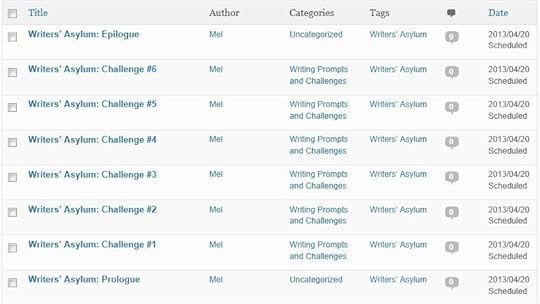
Scheduled and ready to drop!
That was the last bit of organisation for me. All I need to do now is run the day. I’m so excited to see what people think of it all. Can’t wait!
Will you be joining in? Coming in person, or online?
March 29, 2013
Random Writing Tip #1: Write
I come across a lot of advice in my internet forays. Some of it is good; some of it is pretentious twaddle. Some of it is pure gold and those bits I hug to my chest like furbabies.
I babble a lot on this blog. Big, fat posts that I try to cram full of information. That doesn’t suit everyone, and sometimes they’re hard for me to find time to put together. So I’m going to try something a little bit different: random writing tips. Maybe I’ll even pick a regular day to get them posted. Who knows, maybe I’ll even find a schedule and stick with it.
To kick us off, here’s my #1 tip for writers: WRITE.
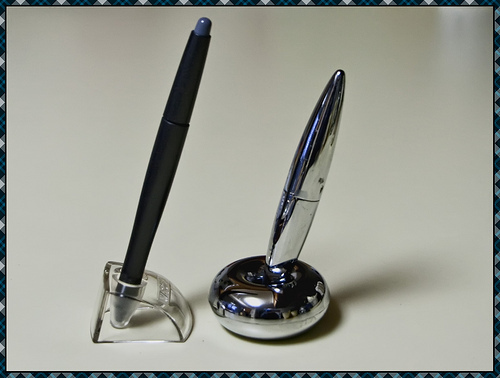
Grab one of these. Go crazy. Or, if you like, type.
(Picture by KaCey97007)
What does it mean? It means that if you want to write, then go write. If you call yourself a writer, then go write. If you have a story to tell, then go write.
No excuses. Not even to yourself.
Got a busy life? Tough. You can find the time; thousands of writers everywhere manage it, and so can you. It’s possible to make time, so do it.
Don’t know where to start? It doesn’t matter; start anyway, start anywhere. You can always come back and perfect the beginning later (and it’s often better done that way!).
Don’t know if you can do it? You’ll never know unless you try. Have a go. Stop prevaricating.
Need to do research? So do it. Research enough to get started, and then start writing.
Blocked on your current project? Write something different. Grab a random prompt and put pen to paper. Make fresh words.
Computer broken? Pens and paper are cheap. Use anything to hand: post-its, napkins, bathroom walls (I will deny encouraging grafitti).
Write a story, write a poem. Write that letter you’ve always wanted to write but never dared. Write about the lessons you’ve learned. Gather up those thoughts that niggle at the back of your brain and spill them onto paper. You can do it.
It doesn’t matter if it’s crap. It doesn’t matter if you throw it away at the end of the day. Just write.
You will surprise yourself. You will develop habits and find yourself craving the sweet release of words. You will create something.
Then, you will be a writer.
Brought to you courtesy of today’s wordvomit.
March 28, 2013
Independent vs Traditional Publishing: Contracts
(Part of the indie vs trad series.)
I’ve already written about creative control and services, and the trade-offs that are made when you choose a publishing route. But something came to my attention recently, so let’s talk about contracts and what you should expect from them.
This ‘something’ was a flurry of blog posts about the new scifi/fantasy e-publishing imprint of Random House publishers: Hydra (along with sister-imprint, Alibi). Particularly, their publishing contracts, and the blog posts in question were not enthusiastic or, in fact, positive in anyway. In John Scalzi’s words, “This is a horrendously bad deal and if you are ever offered something like it, you should run away as fast as your legs or other conveyances will carry you.”
Bold words. On reading the terms of the contract, however, I’m inclined to agree with him.
In short, the main points are:
No advance. The author is paid royalties only. This is very unusual for a publishing contract (and incredibly objectionable for most).
Author pays for all services. The ones I listed in the table on the services post? It’s the same – and possibly worse – than the self-publishing options; the author bears all the cost. If there’s a paper book edition, the author pays for the printing costs, too. The publishing house is simply providing all the services, and you are tied in to paying for their services. You don’t have any control over what services are done/used or how much they cost; you are, in effect, the publishing house’s customer. Which means they can make a profit from you. On the plus side, it comes out of your royalty, rather than being an up-front cost to you (this is an incredibly small plus).
Publisher retains all copyrights for the term of copyright. That’s longer than your life span (usually life +35 or 70 years). As Writer Beware points out, there’s no information about whether the rights might revert to you if the book goes out of print, but as this is primarily aimed at e-publishing and ebooks don’t tend to go out of print, this is a huge red flag. Very precise wording is required to give you any recourse to reclaim the rights to your work.
What does all this mean? It means that this is a vanity publishing contract, not a traditional one. It has all of (and possibly more than) the restrictions of a standard traditional contract but none of the benefits. The chances of an author actually making any money off the book are incredibly small, unless you’re lucky enough to have a runaway bestseller (and how often does that happen, really?).
In a traditional publishing contract, the publisher invests in your book. They put their money where their mouth is and take a risk on you and your work. This investment is part of why they’ll work so hard to sell your book; they have to recoup their costs before they make a profit. For Hydra (and contracts like theirs), there is no risk. All of the risk is taken by the author and it’s the publisher who is making money hand over fist before the creator sees a single cent.
In a deal like this, it is entirely possible for you to never get paid for your work. Meanwhile, the publisher is making money off every sale. This is known in the trade as ‘Hollywood accounting‘, and is a known way for publishing houses to basically scam creators.
Naturally, Random House has come back and refuted the negative vibe that these contract terms are generating. You can read the open letter from RH’s Publishing Director on Publishers Weekly and Writer Beware. They are pitching it as an awesome new style of partnership between an author and a publisher, in which everyone wins and fantastic new stories are released into the wild to skip through the literary daisies.
Bollocks. I know spin doctoring when I see it, and this is no partnership. The investment and risk is one-sided and I see no benefit for a writer to sign this contract.
To be fair (and I always try to be fair), apparently Hydra is willing to negotiate the terms of this contract. Better and more palatable deals can be made. However, as Scalzi and others point out, the fact that they’d try to offer a writer such a contract is appalling in itself. It preys on new and desperate writers, particularly those without agents (who would be all over a contract like that) or experience in the business.
What’s interesting is that Random House have realised that their spin doctoring isn’t working. They have taken the (very loud and nearly violent) criticism from various sources (including those I’ve linked to), and they have changed the contracts. There is now a (slightly-)revised ‘profit-sharing’ contract and a (more) ‘traditional’ contract on offer. Are the contracts better? Yes. Are they good enough?
Honestly, I don’t think so. There are still very tricky spots in those contracts and I’d be incredibly nervous about straying too close to them.
Kudos to Random House for listening to feedback. But they still have a long way to go before these contracts are anything approaching reasonable for an author to put their time and work into.
What does this mean in terms of traditional vs independent publishing? Well, whichever way you go, be very careful about what contracts you’re signing. Even as a self-publishing author, you have to sign deals with distributors and retail vendors.
Don’t know how to tell if a contract is reasonable or not? Any good writer’s organisation (SFWA, RWA, QWC, etc) will have facilities available to its members and they should help you to look over any publishing contract. For non-members, there’s often advice on their sites for free (but I’d highly recommend becoming a member, for this and other benefits). It’s really important to understand what you’re signing away and the long-term implications it might have for you.
Next up: Availability
Flagging sales
The Apocalypse Blog ebooks had a good year in 2012. After Book 0 went free, sales rocketed on Amazon and I started to get cheques through every month. Colour me one happy writer, actually being paid for the fiction that I share with the world.
However, the end of 2012 saw a dip in sales on Amazon. In January, they fell even lower. I started to get incredibly concerned – had the books saturated its audience? Had they had their day? Was I looking at a sad decline, until I was getting only a sad dribble in sales, from now unto forever? I was doing nothing different, so what made the difference?
Curiously, in February, the sales picked up again. Not back to their previous levels, but certainly looking brighter than before.
Also interestingly, my sales through Smashwords (and its distribution network) stayed roughly the same, maybe increasing a little (it’s harder to track these ones, because it requires consolidating a lot of disparate info, and I’m still working on the spreadsheets for this. A financial genius I am not).
For the funsies, here are some graphs of Amazon sales to show you the patterns I’m talking about. Let’s start with the overall sales revenue figures:
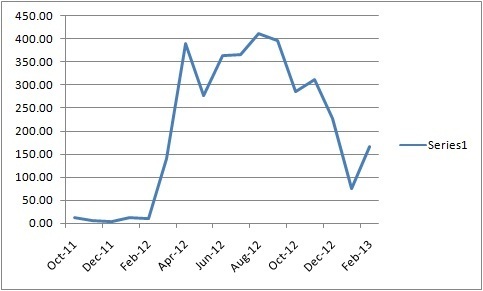
Sales revenue
You can see pretty clearly here what happened when Amazon price-matched Book 0 and made it free: in March, the sales shot up. Note: this is sales revenue, so this is the effect it had on the paid-for books!
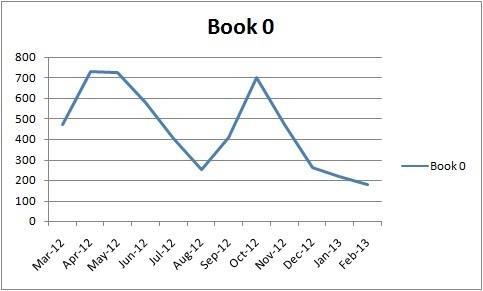
Sales of Book 0, the free one.
You can see the summer holidays pretty clearly in that one. The graph only covers the period from after the book went free – before then, it was just 1 or 2 sales per month. Let’s forget about those early months.
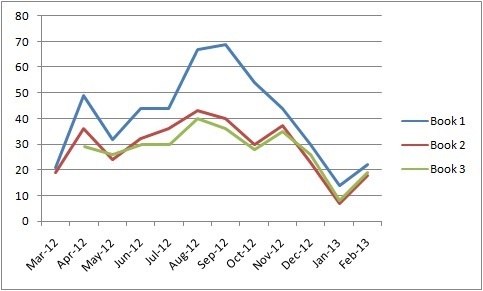
Sales of Books 1, 2, and 3
This is what the sales of the paid-for books look like over the same period. Interestingly, the pattern is quite different – summer seems to have been a bumper time for buying books. Books 2 and 3 sell roughly the same amount, so the knock-on series sales seems to be pretty reliable; if they get past Book 1, they’ll buy all of them. I think I like this pattern. Also, you can see the hike around August where I dropped the price of Book 1 to $2.99 (from $4.99). Another spike. Hello, sweet spot.
To make some of the implications and patterns a little more obvious, here’s the two graphs above merged into one:
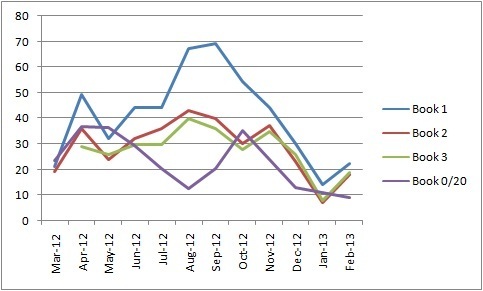
Sales of Books 0, 1, 2, and 3, with 0′s brought down for comparison (divided by 20).
The sales of free vs paid books is almost completely inverse. Curious pattern! I wonder why this is, especially as I would have thought that the knock-on from the free teaser into paid series would have been stronger. Apparently, this is not the case. Why? Hard to say. Perhaps the teaser is a little too much of a teaser? Some food for thought.
What’s pretty undeniable is the drop-off towards the end of 2012. It’s not a nice trend. On the upswing now, but for how long?
And here is the Amazon ranking chart from October until today (sadly, they only brought in Amazon author rankings in October, so I don’t have figures from before then, and the individual book ranks are currently broken):
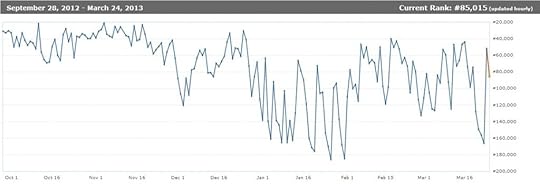
Amazon rankings across all books
You can see the drop-off through January, but considering there was a steady drop-off in sales after October, the ranking is pretty erratic. If the average rank per week is taken, it’s a bit easier to see:
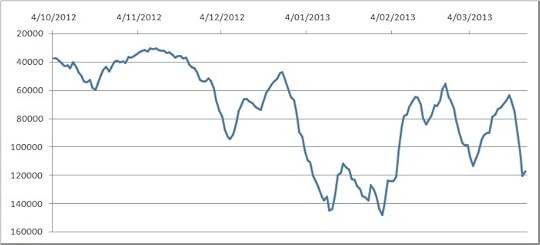
Weekly average Amazon ranking
The ranking changes don’t seem to match the actual sales figures, which is a bit interesting. However, the overall downward trend exists in both sales and ranking figures.
So my first question is: why the change? It’s a little hard to fathom, but it could be due to a number of factors, such as:
The time of year. I’ve noticed some patterns with sales around holidays, but I don’t have any historic data to compare it to, so this one is hard to be sure about. However, post-Christmas slumps are not unknown.
Amazon’s overall sales performance. Very hard to verify, but the author ranking patterns above should give me a clue, as it reflects my sales against other authors and books on Amazon. The mis-match between sales and ranking puts me in mind of the predictions made on the Smashwords blog that Amazon will start to lose market share this year as other online bookstores begin to take over in this space. So at least a part of this trend might not be related to me or my books at all.
I haven’t released a new book for a while. Much of the advice I’ve seen about self-publishing and e-publishing say that readers are voracious and a good way to stay in their line of sight is to release new ebooks fairly frequently (every few months or so). The longer I go without releasing something, the more I fall out of sight? Seems plausible.
Reviews and ratings. I consistently get 4- and 5-star reviews on Amazon, and most other stores (where I have any ratings at all). The reviews are largely positive and encouraging. However, there are some stores where my books don’t have any ratings at all, and that’s a problem I should tackle.
So what can I do about it all? Should I do anything at all? I have a few options, so let’s take a look at them:
Do nothing. I could put it down to market vagaries and the time of year, and ride along in my merry little boat, hoping the tide will swell back in my direction. As tempting as this might be, I’d rather try a few things first.
Release some new books. I have plans in this area for the upcoming Starwalker project. The usefulness of frequent releases is part of why I want to release the short stories as individual books: I don’t have to wait for them all to be finished before I can release them, and I can space out the releases to keep interest in my work.
Release another Apocalypse Blog book. As much as I’d like to do this (in no small part due to the requests I’ve had to continue the story), I don’t have time in my current schedule to write a fourth book. It would take probably a year to come up with a fourth book, by which point the ‘catching interest’ element will most likely have passed me by. It might happen one day, but it’s not at the top of my list right now.
Rejuvenate the existing Apoclaypse Blog books. There are a few ways I could do this: small changes that might make a big difference.
That’s the big picture. Releasing new ebooks is in the pipeline but it will be a while; there’s a lot of work to do there. They won’t be in the AB series, but hopefully it’ll pop my name up on readers’ lists and I’ll get some knock-on sales. In the meantime, I can look into doing something to jog the existing ebook sales. Smashwords had an interesting post on how to rejuvenate flagging book sales, and I’ve got a few things in the works that should help, too:
Fresh edit and proof of the manuscript. This is underway and I’m hoping to have a new edition of the ebooks available soon. This is mostly removing typos, not rewriting sections.
Make Book 1 free. I’ve been pondering whether I should do this for a while, and the strong feeling I’m getting is ‘yes’. It’s a great way to hook people into the series, and the success that followed Book 0 going free is proof of that.
Lower the price of Books 2 and 3. Similar to the point above. It’s mostly about removing potential barriers to sale. At the least, I’ll probably lower Book 2 when it becomes the first paid-for book in the series. They’re long books, but more sales net me more benefit than higher per-book profits do.
Redo the product descriptions for the books. This might freshen up the listings, and maybe sharpen the message for readers. I’ve learned things since I released the ebooks, so there could be improvements made here. Make sure it’s pinging all the right areas for the audience I’m trying to reach.
Get new covers. This one is tricky, because it will (or at least could) cost me money. Also, I have a deep love of the current covers; they’re so pretty. However, they don’t scale terribly well (particularly to thumbnails), and it might be possible to get something better and more eye-grabbing. Open to options here. Maybe just a re-imagining of the current look? Should I shoot for four distinctly different covers, instead of recolourings of the same one for that ‘matched set’ vibe?
It’s not a lot of work, so I might as well get moving on it. Changing the prices takes all of ten minutes (though the change of Book 1 to free will take a few months to ripple through to Amazon, if Book 0 is anything to judge by). I’d like all of the changes to hit at once – to maximise the impact, rather than dribbling it through - so somehow I have to coordinate all of those changes. The covers are probably the trickiest to get done, so perhaps I’ll kick that off sooner rather than later.
As if I needed any more balls to keep in the air. At least it keeps things interesting, right?
Wish me luck and better sales. Oh, and don’t forget to tell everyone you know to buy my books! Thanks! :D
March 27, 2013
Next Big Thing Blog Hop
What is a blog hop? Basically, it’s a way for readers to discover authors new to them. I hope you’ll find new-to-you authors whose works you enjoy. On this stop on the blog hop, you’ll find a bit of information on me and one of my works, and links to three other authors you can explore!
My gratitude to fellow author Kimberley Linstruth-Beckom a.k.a Amanda Kimberley for inviting me to participate in this event. You can click the following link to learn more about her work: http://www.fibroandfabulous.com
In this blog hop, I and my fellow authors, in their respective blogs, have answered ten questions about our book or work-in–progress (giving you a sneak peek). We’ve also included some behind-the-scenes information about how and why we write what we write–the characters, inspirations, plotting and other choices we make. I hope you enjoy it!
Please feel free to comment and share your thoughts and questions. Here is my Next Big Thing!
 1: What is the working title of your book?
1: What is the working title of your book?
The series I’m working on right now is Starwalker. It’s currently a web serial, but this year I’m aiming to release it in ebook form. I’m still working out the names of the books, but I’m pretty sure the first one will be Star Made. On the web serial site, the first book is called Identity.
2: Where did the idea come from for the book?
While I was writing The Apocalypse Blog, I got to thinking about what I could do next with a blogfic. I had done the ‘voice from the end of the world’, and I wanted a new challenge. What popped into my head was initially a captain’s log, harking back to Star Trek: The Next Generation, which I watched a lot as a teenager. That led me to ship’s logs, and the way they used to be (and still are, in many cases) kept for nautical ships. Smoosh the two together with a bit of a twist on top, and you get Starwalker: the ship’s log as told by the ship.
3. What genre does your book come under?
Science fiction. I’ve heard it referred to as space opera, but it’s also heavily dosed with adventure and mystery. Maybe even a trace of romance in the later books. But it’s definitely science fiction. The main character is a starship, after all.
4: Which actors would you choose to play your characters in a movie rendition?
I very rarely peg my character so solidly. I prefer to let the readers draw their own images. The closest I’ve got with this is when I was having the graphics done of the ship’s avatar, and I described Danika/Starry as being based on Alecia Moore/Pink.
5: What is the one-sentence synopsis of your book?
A ship’s log, as told by the ship.
6: Is your book self-published, published by an independent publisher, or represented by an agency?
I’m currently planning on self-publishing Starwalker as ebooks. I may shop it around to publishers or agents at some point, but for now, I’m focussing on finishing up the first main story arc (which ends with Book 3), and pulling it together as ebooks.
7: How long did it take you to write the first draft of your manuscript?
Well, it’s an ongoing serial, and I’m averaging about a book a year. So it took me about a year to write the first book, and it’s looking like it will take me three and a half years to finish up the first trilogy. It has been a long and fun journey!
8: What other books would you compare this story to within your genre?
The closest that I can think of would be Anne McCaffery’s brain-ship series, for the ship side of things. Similarly, the Andromeda TV show is one of the inspirations, though I sought to do something different to both of those stories. It’s not as heavy as Peter Hamilton’s work; it’s closer to Asimov’s, though with more of a focus on people rather than technology.
If you like character-centric stories, this one is for you; you don’t need to read science fiction or space-based stories to enjoy it. I’ve had many readers tell me this explicitly!
9: Who or what inspired you to write this book?
It’s hard to point to a specific inspiration. Question 2 lays out where the idea originally came from, and the stories mentioned in Question 8 are some of the inspirations for the characters and situations. I like gnarly moral situations and gritty settings, like Farscape. I wanted to explore the melding of human and machine, both in mind and body, and that led to elements like the ship’s personality and some of her crew (like Rosie, who is mildly obsessed with augmenting her strength, and the pirate Lieutenant, who was less willing about his prosthetics and cybernetics).
There’s also a world around these characters that I wanted to explore for a while, based on the rise of corporate power. It’s not there to make any kind of statement; it is a situation that I find interesting to put people into and see what happens. I’m as interested in the implications of societal forces as I am in technological ones. Personal freedom, morality, and ownership are other elements and themes that interest me, as well. Together, these mix up to make the world the Starwalker flies through. Already, I have a lot more stories in mind to tell, more facets to uncover. But this is my first foray and, I hope, a good start.
10: What else about your book might pique the reader’s interest?
The Starwalker Saga is an adventure that starts on the decks of a single ship and ends up spanning a galactic network of colonies and deciding the fates of the stars themselves.
There are space pirates, battles, and chases through asteroid belts. There are love stories and broken hearts. There are robots on board the ship who are wilful, part of her subconscious, and occasionally hilarious. There’s loss and hard-won success.
You don’t need to know science to read the story. On the other hand, I’ve had scientists tell me that they weren’t thrown out of the story by the science that’s in there. It’s a story about people in an extraordinary situation, which I hope everyone can enjoy.
There also might be plushies one day, because everyone wants to hug a starship. Read the story and you’ll see what I mean!
Who’s next on the NEXT BIG THING BLOG HOP?
So glad you asked! Below you will find authors who will be joining me by blog, next Wednesday. Do be sure to bookmark and add them to your calendars for updates on works in progress and new releases! Happy writing and reading!
Khaalidah Mohammed-Ali’s blog: Khaalidah
Matthew Williams’s blog: Stories by Williams
Raymond Gates’s blog: Dreaming
Daniel Ferguson’s blog: The Dark Word




